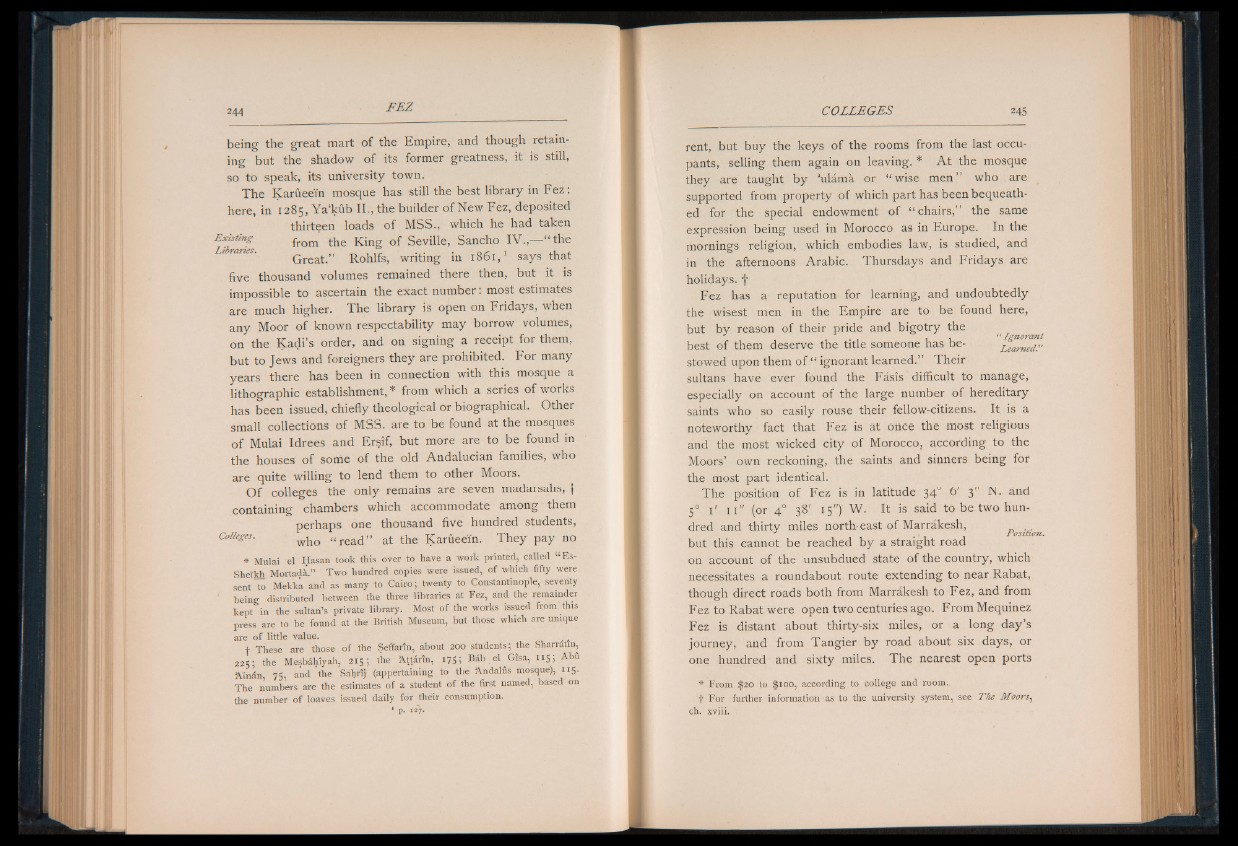
being the great mart of the Empire, and though retaining
but the shadow of its former greatness, it is still,
so to speak, its university town.
The Karueei'n mosque has still the best library in Fez:
here, in 1285, Y a ’kub II., the builder of New Fez, deposited
thirteen loads o f MSS., which he had taken
Existing from the Ki of Seville, Sancho IV.,— “ the
Libraries. '■» \ „ . . . r* 1 , 1 L
Great.” Rohlfs, writing in 18 6 1 ,1 says that
five thousand volumes remained there then, but it is
impossible to ascertain the exact number: most estimates
are much higher. The library is open on Fridays, when
any Moor of known respectability may borrow volumes,
on the Kadi’s order, and on signing a receipt for them,
but to Jews and foreigners they are prohibited, f o r many
years there has been in connection with this mosque a
lithographic establishment, * from which a series of works
has been issued, chiefly theological or biographical. Other
small collections of MSS. are to be found at the mosques
of Mulai Idrees and Ersif, but more are to be found in
the houses of some of the old Andaluciari families, who
are quite willing to lend them to other Moors.
O f colleges the only remains are seven madarsahs, f
containing chambers which accommodate among 'them
perhaps one thousand five hundred students,
Colleges. who (iread>> at the Karueei'n. They pay no
* Mulai el Hasan took this over to have a work printed, called “ Es-
Sheikh Mortada.” Two hundred copies were issued, of which fifty were
sent to Mekka and as many to Cairo; twenty to Constantinople, severity
being distributed between the three libraries at Fez, and the remainder
kept in the sultan’s private library. Most of the works issued from this
press are to be found at the British Museum, but those which are unique
are of little value. ■
+ These are those of the Seffarln, about 200 students; the Sharrritm,
22s; the Mesbrihiyah, 215; the Attdrin, 175; Bab. el Gisa, 115; Abu
Ainrin, 75, and the Sahrij (appertaining to the Andalus mosque), 115.
The numbers are the estimates of a student of the first named, based on
the number of loaves issued daily for their consumption.
1 p . 1 2 7 .
rent, but buy the keys of the rooms from the last occupants,
selling them again on leaving. * A t the mosque
they are taught by ’ulama or “ wise men” who are
supported from property of which part has been bequeathed
for the special endowment of “ chairs,” the same
expression being used in Morocco as in Europe. In the
mornings religion, which embodies law, is studied, and
in the afternoons Arabic. Thursdays and Fridays are
holidays, f
Fez has a reputation for learning, and undoubtedly
the wisest men in the Empire are to be found here,
but by reason of their pride and bigotry the
1 11 Ignorant
best of them deserve the title someone has be- Learned.
stowed upon them of “ ignorant learned.” Their
sultans have ever found the Fasis difficult to manage,
especially on account of the large number of hereditary
saints who so easily rouse their fellow-citizens. It is a
noteworthy fact that Fez is at once the most religious
and the most wicked city of Morocco, according to the
Moors’ own reckoning, the saints and sinners being for
the most part identical.
The position of Fez is in latitude 34° 6' 3" N. and
5° 1' 11" (or 40 38' 15'')' W. It is said to be two hundred
and thirty miles north-east of Marrakesh,
J ‘ 1 1 Position.
but this cannot be reached by a straight road
on account of the unsubdued state of the country, which
necessitates a roundabout route extending to near Rabat,
though direct roads both from Marrakesh to Fez, and from
Fez to Rabat were open two centuries ago. FromMequinez
Fez is distant about thirty-six miles, or a long day’s
journey, and from Tangier by road about six days, or
one hundred and sixty miles. The nearest open ports
* From $20 to $100, according to college and room.,
t For further information as to the university system, see The Moors,
ch. xviii.